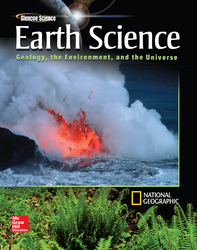1 A) plagioclase feldspar B) gypsum C) quartz D) orthoclase feldspar 2 A) radio waves B) microwaves C) ultraviolet D) gamma rays 3 A) refracting B) reflecting C) Very Large Array D) interferometry 4 A) by velocity B) by color C) by wavelength and frequency D) by oscillations 5 <a onClick="window.open('/olcweb/cgi/pluginpop.cgi?it=jpg::::/sites/dl/free/0078746361/561698/113moon_gm_280p_t5.jpg','popWin', 'width=NaN,height=NaN,resizable,scrollbars');" href="#"><img valign="absmiddle" height="16" width="16" border="0" src="/olcweb/styles/shared/linkicons/image.gif"> (37.0K)</a> A) B B) C C) Both formed at the same time. D) It is impossible to tell. 6 A) larger, closer to B) larger, farther from C) smaller, closer to D) smaller, farther from 7 A) rille B) sandstone C) regolith D) maria 8 A) an infrared telescope B) a refracting telescope C) interferometry D) a refracting telescope 9 A) lunar breccias B) sandstones C) lunar conglomerates D) volcanic rocks 10 A) the area of the opening B) the shape of the opening C) the number of mirrors D) the configuration of the lenses 11 <a onClick="window.open('/olcweb/cgi/pluginpop.cgi?it=jpg::::/sites/dl/free/0078746361/561698/166_craters_ca_281c.jpg','popWin', 'width=NaN,height=NaN,resizable,scrollbars');" href="#"><img valign="absmiddle" height="16" width="16" border="0" src="/olcweb/styles/shared/linkicons/image.gif"> (25.0K)</a> A) rays B) highlands C) rilles D) impact crater 12 <a onClick="window.open('/olcweb/cgi/pluginpop.cgi?it=jpg::::/sites/dl/free/0078746361/561698/111_sunlt_gm_280p.jpg','popWin', 'width=NaN,height=NaN,resizable,scrollbars');" href="#"><img valign="absmiddle" height="16" width="16" border="0" src="/olcweb/styles/shared/linkicons/image.gif"> (23.0K)</a> A) north pole B) equator C) between the Tropic of Cancer and the north pole D) Tropic of Cancer 13 A) the simultaneous formation B) the plate tectonic theory C) the impact theory D) the capture theory 14 A) full moon B) waxing crescent C) new moon D) waning gibbous 15 A) less than normal, neap tide B) greater than normal, neap tide C) greater than normal, spring tide D) less than normal, spring tide 16 <a onClick="window.open('/olcweb/cgi/pluginpop.cgi?it=jpg::::/sites/dl/free/0078746361/561698/final_moon_phases.jpg','popWin', 'width=NaN,height=NaN,resizable,scrollbars');" href="#"><img valign="absmiddle" height="16" width="16" border="0" src="/olcweb/styles/shared/linkicons/image.gif"> (12.0K)</a> A) 16 B) 17 C) 18 D) 19 17 <a onClick="window.open('/olcweb/cgi/pluginpop.cgi?it=jpg::::/sites/dl/free/0078746361/561698/final_moon_phases.jpg','popWin', 'width=NaN,height=NaN,resizable,scrollbars');" href="#"><img valign="absmiddle" height="16" width="16" border="0" src="/olcweb/styles/shared/linkicons/image.gif"> (12.0K)</a> A) 19-21 B) 15-18 C) 17-19 D) 21-15 18 A) impact craters B) running water C) heavy erosion D) lava flows 19 A) The crust is half as thin on the far side. B) There were no impacts on the far side. C) Lava did not fill in the far side. D) The crust is twice as thick on the far side. 20 A) The Sun's light becomes dimmer during the day. B) The Moon passes between the Sun and Earth. C) Earth passes between the Sun and the Moon. D) The Sun, the Moon and Earth are positioned at right angles to each other.





